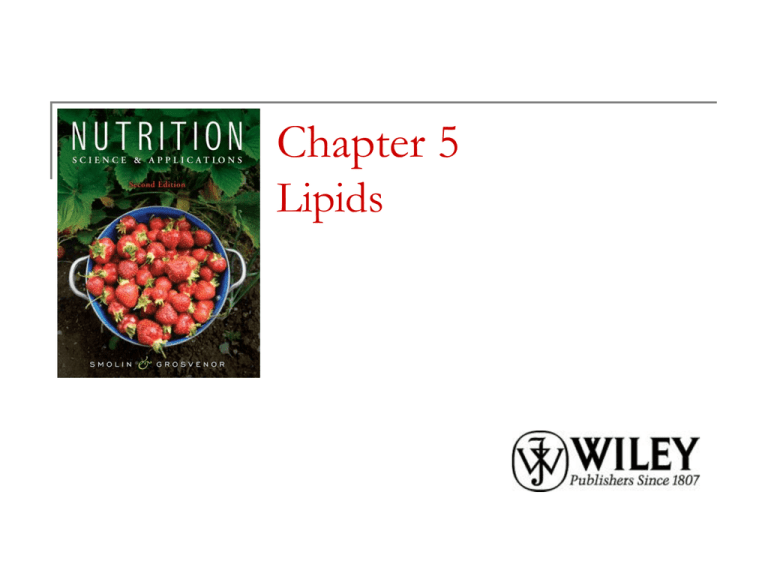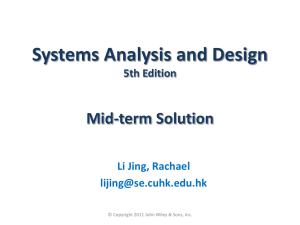
Chapter 5
Lipids
Why may sugar alcohols be used in products
labeled “sugar free” or “no sugar added”?
Sugar alcohols provide no kilocalaries incorrect,
they provide differing amounts kcal
Sugar alcohols are not derivatives of sugars
incorrect, some are derived from sugar which has
undergone chemical processing such as
hydrogenation
Sugar alcohols are not monosaccharides or
disaccharides. incorrect
Sugar alcohols are not absorbed into the body.
Copyright 2010, John Wiley & Sons, Inc.
correct
Lipids
Lipid is the chemical term for fat.
Lipids contribute texture, taste, flavor and
aroma to foods.
Fats and oils contain 9 calories per gram.
The typical American diet contains about
33% of its energy from fat.
Copyright 2010, John Wiley & Sons, Inc.
Fat Intake Affects Health
Copyright 2010, John Wiley & Sons, Inc.
Triglycerides
Triglycerides are the major form of lipid in
food and in the body.
Triglycerides consist of three fatty acids
attached to a glycerol molecule.
If only one fatty acid is attached to the
glycerol it is called a monoglyceride.
Copyright 2010, John Wiley & Sons, Inc.
Triglycerides
Copyright 2010, John Wiley & Sons, Inc.
Review: Monosaccharide structure
Copyright 2010, John Wiley & Sons, Inc.
Most fatty acids in food and in the
body are bound to a molecule
called
cholesterol.
phospholipids.
lecithin.
glycerol.
Copyright 2010, John Wiley & Sons, Inc.
Fatty Acids
The carbon chains of fatty acids vary in length from
a few to 20 or more carbons.
Short-chain fatty acids range from 4-7 carbons and
remain liquid at room temperature.
Coconut oil is a medium chain fatty acid.
Copyright 2010, John Wiley & Sons, Inc.
Saturated fatty acids contain
carbons in a chain that are
bound to two hydrogens.
•Most animal fats contain
saturated fatty acids.
Unsaturated fatty acids contain
some carbons that are not
saturated with hydrogens.
•Omega-3 and omega-6 fatty
acids are unsaturated fatty
acids.
Copyright 2010, John Wiley & Sons, Inc.
Fatty Acids
Copyright 2010, John Wiley & Sons, Inc.
Foods consisting mostly of fatty
acids with only single bonds tend
to be
solid at room
temperature.
soluble in water.
liquid at room
temperature.
gaseous at room
temperature.
Copyright 2010, John Wiley & Sons, Inc.
The end of a fatty acid chain
containing a methyl group is also
referred to as the __________
end.
omega
alpha
delta
beta
Copyright 2010, John Wiley & Sons, Inc.
Omega-3 and Omega-6 Fatty Acids
Copyright 2010, John Wiley & Sons, Inc.
Trans Fatty Acids
Trans fatty acids can be created by
hydrogenation.
Hydrogenation causes some double bonds
to become saturated.
Hydrogenated fats can be found in
margarines, vegetable shortening and shelfstable baked goods.
Trans fatty acids have be shown to raise
blood cholesterol levels and increase the
risk of heart disease.
Copyright 2010, John Wiley & Sons, Inc.
Fatty Acids in Food
Copyright 2010, John Wiley & Sons, Inc.
Phospholipids
Phospholipids are lipids attached to a
phosphate group.
Phosphoglycerides are the major class of
phospholipids.
Phosphoglycerides can act as emulsifiers.
Phosphoglycerides form a lipid bilayer in
membranes, helping to regulate what can
pass into and out of a cell.
Copyright 2010, John Wiley & Sons, Inc.
Phospholipids
Copyright 2010, John Wiley & Sons, Inc.
Phospholipids consists of glycerol
with __________ attached.
3 fatty acids
3 amino acids
2 fatty acids, and a
phosphate group
cholesterol
Copyright 2010, John Wiley & Sons, Inc.
Sterols
Sterols are a type of lipid found in plants and animals.
Sterols do not dissolve in water.
Cholesterol is a type of sterol found only in animals.
90% of cholesterol in the body is found in cell
membranes.
Diets high in cholesterol (from animals) can increase
the risk of heart disease.
Plant sterols can help reduce cholesterol in the body.
Copyright 2010, John Wiley & Sons, Inc.
Copyright 2010, John Wiley & Sons, Inc.
Bile, vitamin D, and some
hormones such as testosterone
and estrogen are derived from
essential fatty
acids.
cholesterol.
trans fatty acids.
phospholipids.
Copyright 2010, John Wiley & Sons, Inc.
Chylomicrons
Chylomicrons are a combination of
triglycerides, cholesterol, phospholipids and
a small amount of protein.
Chylomicrons help to transport long-chain
fatty acids into the lymphatic system and
into the blood stream without passing
through the liver.
Copyright 2010, John Wiley & Sons, Inc.
Chylomicrons
Copyright 2010, John Wiley & Sons, Inc.
Chylocmicrons are formed in:
the intestine
the liver
the lymph
the blood
Copyright 2010, John Wiley & Sons, Inc.
Reverse cholesterol transport is
accomplished by
a)
chylomicrons.
b)
LDLs.
c)
VLDLs.
d)
HDLs.
Copyright 2010, John Wiley & Sons, Inc.
Lipoproteins
Lipoproteins are transport particles for
water-insoluble lipids.
Lipoproteins are created by combining
water-insoluble lipids, phospholipids and
proteins.
Lipoproteins help transport triglycerides,
cholesterol and fat-soluble vitamins from the
small intestine and stored lipids from the
liver.
Copyright 2010, John Wiley & Sons, Inc.
Lipoproteins
Copyright 2010, John Wiley & Sons, Inc.
http://s496.photobucket.com/albums/rr329/sergeek/?action=view¤t=colesterol
2.jpg
Copyright 2010, John Wiley & Sons, Inc.
Low-Density Lipoproteins
The liver is the major lipid-producing organ
in the body.
Triglycerides produced in the liver are
incorporated into entities called very-lowdensity lipoproteins (VLDLs).
VLDLs transport lipids out of the liver and
deliver them to cells in the body.
The enzyme lipoprotein lipase removes
triglycerides from VLDLs, creating
intermediate-density lipoproteins (IDLs).
Copyright 2010, John Wiley & Sons, Inc.
Low-Density Lipoproteins
Approximately two-thirds of IDLs return to the
liver; the remainder are transformed in the blood
into low-density lipoproteins (LDLs).
LDLs contain less triglyceride and more
cholesterol than VLDLs. LDLs deliver cholesterol
to the cells.
If the amount of LDL cholesterol in the blood
exceeds the amount that can be used by the
cells, the result is a high level of LDLs.
High levels of serum LDLs have been associated
with an increased risk for heart disease.
Copyright 2010, John Wiley & Sons, Inc.
High-Density Lipoproteins
Most cells cannot break down cholesterol.
Cholesterol is returned to the liver to be eliminated from
the body.
This reverse cholesterol transport is done by highdensity lipoproteins (HDLs).
High levels of HDL in the blood help to prevent
cholesterol from depositing in the artery walls.
High levels of HDL are associated with a reduction in
heart disease risk.
Copyright 2010, John Wiley & Sons, Inc.
Lipid Functions in the Body
Most lipids in the body are triglycerides
stored in adipose tissue.
Deposits of adipose tissue help to define
body shape, provide stored energy, insulate
the body from temperature changes and
protect internal organs against physical
shock.
Lipids in the body are important for
lubricating body surfaces, such as the
mucous membranes of the eyes.
Copyright 2010, John Wiley & Sons, Inc.
If you were to analyze the composition
of adipose tissue, you would likely
find an abundance of
a)
micelles.
b)
triglycerides.
c)
eicosanoids.
d)
cholesterol.
Copyright 2010, John Wiley & Sons, Inc.
Lipid Functions in the Body
Cholesterol is used to make several
hormones, including estrogen and
testosterone.
PUFAs help to regulate blood pressure and
blood clotting.
Essential fatty acids are important for
growth, skin integrity, fertility and the
structure and function of cell membranes.
Copyright 2010, John Wiley & Sons, Inc.
Lipid Functions in the Body
Eicosanoids are made from omega-3 and
omega-6 fatty acids. Eicosanoids help
regulate blood clotting, blood pressure and
immune function.
Fatty acids and glycerol can be used to
produce energy in the form of ATP.
Copyright 2010, John Wiley & Sons, Inc.
Lipids Can Be Used to Produce Energy
in the Body
Copyright 2010, John Wiley & Sons, Inc.
Essential Fatty Acid Deficiency
If adequate amounts of essential fatty acids
are not consumed, a deficiency can result.
Symptoms include: dry, scaly skin, liver
abnormalities, poor wound healing, growth
failure in infants and impaired hearing and
vision.
Copyright 2010, John Wiley & Sons, Inc.
Lipids and Cardiovascular Disease
Over 80 million Americans suffer from some
form of cardiovascular disease.
Studies show that diet and lifestyle affect the
risk of developing cardiovascular disease.
Atherosclerosis is a disease in which lipids
and fibrous materials are deposited in artery
walls.
Copyright 2010, John Wiley & Sons, Inc.
Lipids and Cardiovascular Disease
Copyright 2010, John Wiley & Sons, Inc.
Lipids and Cardiovascular Disease
Copyright 2010, John Wiley & Sons, Inc.
Lipids and Cardiovascular Disease
Dietary factors that may help to reduce the
risk of heart disease include:
Consuming omega-3 and omega-6
polyunsaturated fats
Consuming monounsaturated fats
Consuming plant foods, including fruits and
vegetables, whole grains and legumes
Adequate intake of B vitamins
Moderate alcohol consumption
Copyright 2010, John Wiley & Sons, Inc.
Recommendations to Reduce
Blood Cholesterol
Copyright 2010, John Wiley & Sons, Inc.
Tools for Assessing Fat Intake
Copyright 2010, John Wiley & Sons, Inc.
Tools for Assessing Fat Intake
Copyright 2010, John Wiley & Sons, Inc.
Tools for Assessing Fat Intake
Copyright 2010, John Wiley & Sons, Inc.
Tools for Assessing Fat Intake
Copyright 2010, John Wiley & Sons, Inc.
Dietary Fat and Cancer
Dietary Fat has been suggested to be both a
tumor promoter and a tumor initiator.
Copyright 2010, John Wiley & Sons, Inc.
How to Choose Fats Wisely
Copyright 2010, John Wiley & Sons, Inc.
How to Choose Fats Wisely
Copyright 2010, John Wiley & Sons, Inc.
Reduced-Fat Foods
Reduced-fat foods either have fat removed,
have fat replaced or contain fats that cannot
be digested or absorbed.
Fat substitutes can be carbohydrate-,
protein- or fat-based.
Fat-based fat substitutes, such as Olestra
(sucrose polyester), can reduce the
absorption of fat-soluble vitamins.
Copyright 2010, John Wiley & Sons, Inc.
Chapter 5
Copyright 2010 John Wiley & Sons, Inc.
All rights reserved. Reproduction or translation of this work beyond
that permitted in section 117 of the 1976 United States Copyright Act
without express permission of the copyright owner is unlawful.
Request for further information should
be addressed to the
.
Permissions Department, John Wiley & Sons, Inc. The purchaser may
make back-up copies for his/her own use only and not for distribution
or resale. The Publisher assumes no responsibility for errors,
omissions, or damages caused by the use of these programs or from
the use of the information herein.
Copyright 2010, John Wiley & Sons, Inc.









